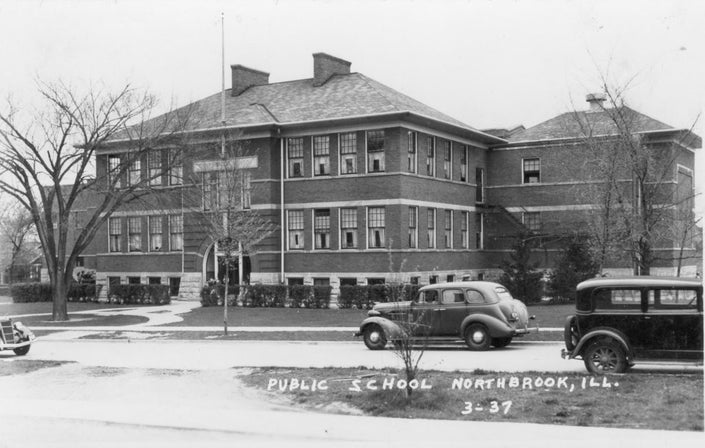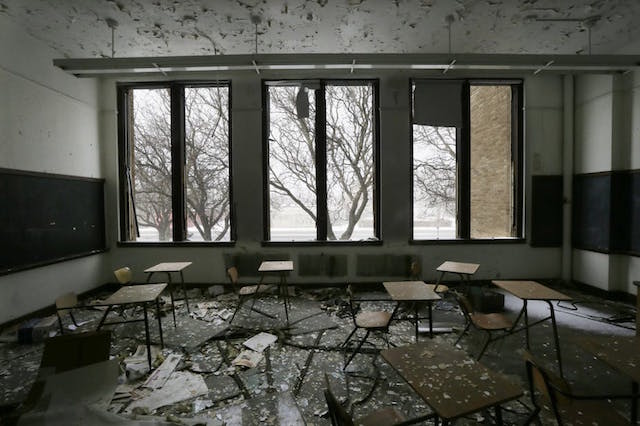Editor’s NOTE: I find the following interesting for many, many reasons.
1) I attended the Crestwood Elementary School, Northbrook, Illinois (below) in 1958 which was most assuredly painted with lead-based paint and possibly built with asbestos.

2) All of the schools which I attended were painted with lead-based paint. As I recently posted on one of our blogs, when I was home from school for a week or so with one of the prime diseases of the day… mumps, measles or chicken pox – my father painted my bedroom – while I was in it – WITH lead-based paint.
3) Back in the day, young children and/or students were recipients of somewhere around 6 vaccinations in their young life (compared to – oh – somewhere north of about ten+ times those numbers today).
4) Somehow – we made it through ALL of this without being as affected as those generations who followed us. No obesity, balanced fresh cooked meals, plenty of exercise and activity, no cell-phones or other electronic toys, minimal television time and – once again – very few vaccinations. Do you think that all of this made a difference?
Consider all of the above as you read through the following column. ~ Ed

Lead-based paint is being found in roughly half of schools that do inspections, a federal report reveals. Carlos Osario/AP
With all the emphasis that has been placed on making sure children are safe from the hazards of lead-based paint at home, similar efforts would seem just as important for America’s schools.
After all, outside of the home, young children spend the majority of their day – 6.8 hours a day – at school.
Yet a new federal report found that an estimated 15.2 million children in the U.S. go to schools in school districts that found lead-based paint. This is happening more than 40 years after the United States’ 1978 ban on the use of lead-based paint in housing.
For years, as a nursing professor and parent educator who specializes in treating children with elevated lead levels, I have worked to identify children with lead poisoning and to help parents make their homes lead-safe.
Lead, breathed in or ingested, can affect children’s brain development and result in reduced “intelligence quotient,” or IQ.
Failure to inspect
The report, released June 24 by the U.S. Government Accountability Office, highlighted how many school districts – 72% – are not even inspecting their buildings for lead-based paint hazards. The Government Accountability Office restricted its analysis to school districts that had at least one school built before 1978, and those that obtained drinking water from a public water system.
Among the 12% that do inspect for lead hazards, more than half found them. That raises questions about what amount could be found in the remaining 88% of schools that aren’t looking.
Lead was more frequently found in large school districts – 51% of the time versus 8% for other districts, according to the report. There could be a number of reasons for these results. These larger districts may have older school buildings, or they may be in larger cities that lack the money to keep schools in a good state of repair.
Parents unaware
The report also reveals that school districts often don’t notify parents or school board members about lead inspection results.
Specifically, 58% of school districts did not notify parents of their findings and 46% did not tell school board members, according to the report. Fifty-nine percent didn’t tell the media, the report states.
To make an impact on lead hazards in America’s schools, there needs to be transparency. As one who has worked directly with lead-poisoned children, I find it interesting how often there is an emphasis on making sure students have things like technology to make sure children learn. The same emphasis needs to be placed on making sure schools are free from hazards, such as those posed by lead-based paint, that threaten children’s ability to learn.
Written by Marilynne R. Wood for The Conversation ~ July 26, 2019


A free and absolutely un-restricted flow of information between interested parties – mainly, to and from the parents – is essential to SOLVING problems. Any problems.
Even when…, no, especially when, the information is so grave, that looking it ‘square in the eye’ is uncomfortable, and extremely difficult to do.